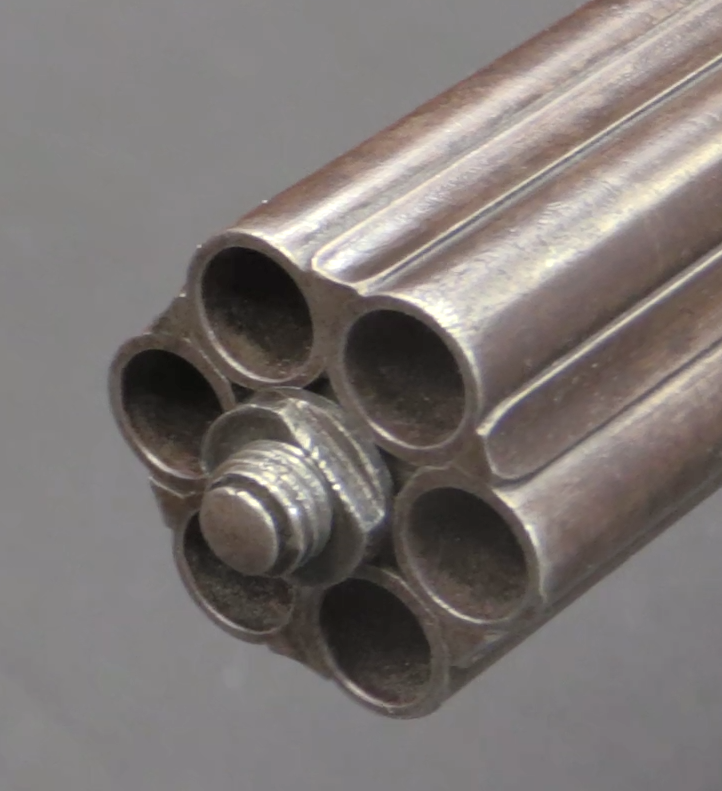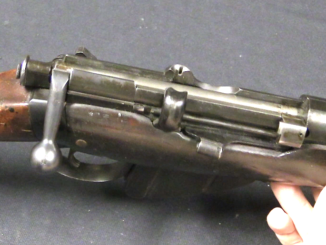Enfield carbines are marvelous little guns, in my opinion, and just ooze history. This particular one is a Royal Irish Constabulary (RIC) carbine, 10,000 of which were converted from obsolete British military Lee Enfield and Lee Metford carbines in 1903 and 1904. Where the British carbines had full-length stocks, the RIC wanted to be able to mount bayonets (specifically, 1888 pattern Metford bayonets). To accommodate this, the carbines were modified with a sleeve to increase the muzzle to the proper diameter and a spliced wood section at the end of the stock to allow a bayonet lug nose cap – which had to be mounted lower than the carbine stock would normally fit.
The Enfield and Metford carbines had been deemed obsolete after the Boer War, when the British army standardized on the new short rifle (the SMLE) to replace both long rifles and carbines. The SMLE included many other changes from the carbine pattern guns, which had different safeties, dust covers on the bolts, 6-round magazines, no stripped clip guides, and sights similar to the earlier Martini-Henry pattern rifles. Finding intact carbines in the US is difficult, as their guns had long military careers and were often updated and modified many times.
Note that the RIC carbine is very similar to the New Zealand contract military carbines, and the two are best differentiated by the wood at the nose cap. The RIC guns have a spliced-in larger section, where the NZ carbines have a smooth taper to the nose. In addition, RIC carbines were made from both Metford and Enfield carbines – the Metfords had been built with sling bars in the side of the stocks, and retained these in their RIC configurations. Enfield carbines used sling swivels on the bottom of the stocks.




Liberals in America today (sometimes rightfully) accuse police of using excessive force whenever taking down a purportedly dangerous individual (excessive force including STRANGLING a suspect with bare hands or filling said suspect with copper-jacketed lead as he runs AWAY from the officer). The Royal Irish Constabulary seems to have been much more blood-thirsty and stab-happy. No matter how corrupt your local policeman might be, don’t antagonize him on purpose unless you want to end up buried in a cheap pine coffin.
Almost all police forces all the way around the world were a lot more willing to apply force, including lethal force, in the past than they are now. It wasn’t until fairly recently that even the idea of “police brutality” was a thing. If you crossed a cop and got beat down, oh well- didn’t matter if it was Marseilles, Detroit, Dublin, or Manchester.
Thanks for this.
Before I emigrated to the US I had a Lee Metford Cavalry Carbine manufactured in 1895. I didn’t know at the time I could have brought it with me.
Neat! While law enforcement (in the US and worldwide) seems to have gone to semiauto or selective fire for situations where patrol rifles are issued and reserve bolt actions for long-range sniper operations, I’m of the rather-hit-wth-one-shot-than-miss-with-30 school and I’ve got a half-century fondness for the Lee action. (When I was a kid in the Midwest in the 60s the only rifle more common in truck rear windows than a .30-30 was a .303.) Anyway, this “obsolete” police carbine reminds me of my main win-the-lottery fantasy purchase – the remanufactured Lee-Enfield made and sold by the Brit company Armalon as the AL42. (I think.) Wow – a 5.56 “Smelly” that uses M16 mags. Rather have that, for fun or patrol, than any AR. And glad to have a web site where I can say such heresy.
“5.56 “Smelly” that uses M16 mags. Rather have that, for fun or patrol, than any AR. And glad to have a web site where I can say such heresy.”
I would rather prefer 7.62×51 (.308 Winchester) if original ammo hard to obtain, anyway it is upon personal fondness.
Well, you’re right. A boltie will have more range and accuracy than an AR.
But isn’t there a reason why semi-auto and full-auto are kings of the battlefield since WW2? Even before, if one goes as far back as the MP-18.
P.S.:
You, heretic? You don’t say? 😉
I have one of these I got at auction a few years ago. It is nearly the most expensive rifle I own, since I coughed up $850 for it. It is the Lee Enfield, made in 1898 and converted in 1902. The furniture is beat up, but otherwise it is in pretty good shape.